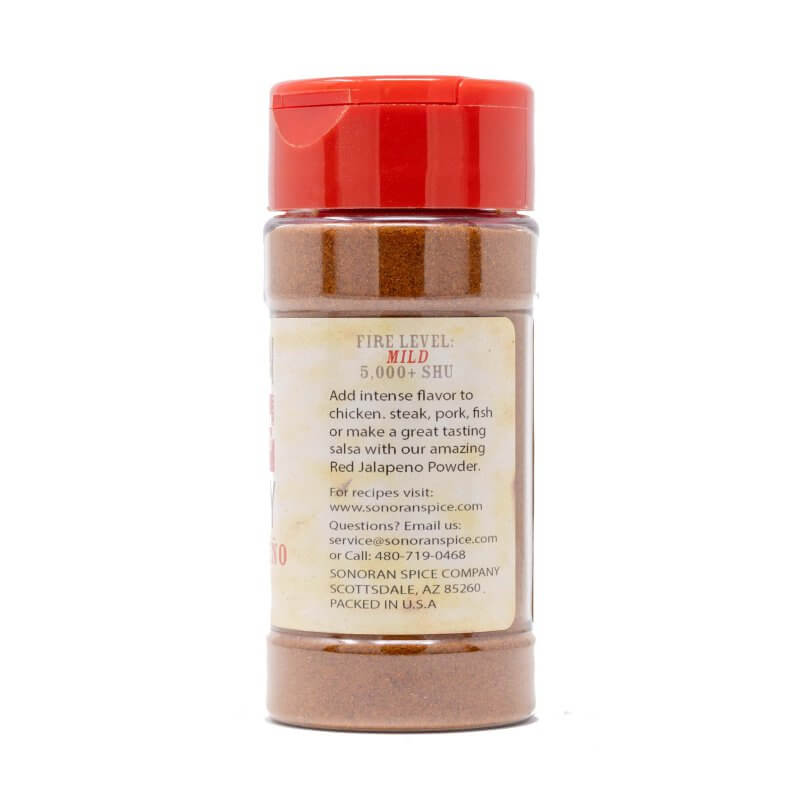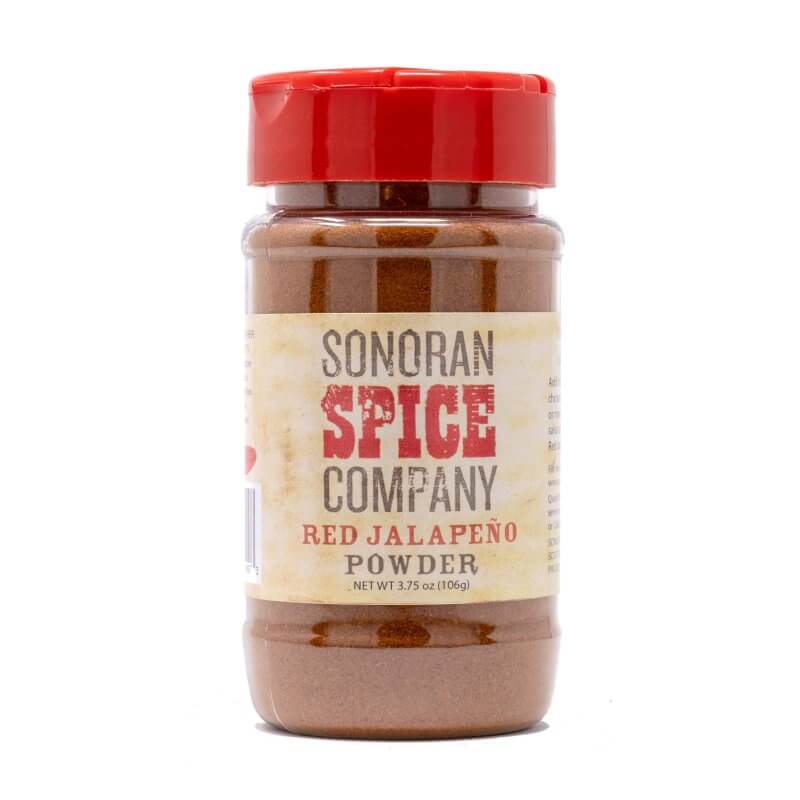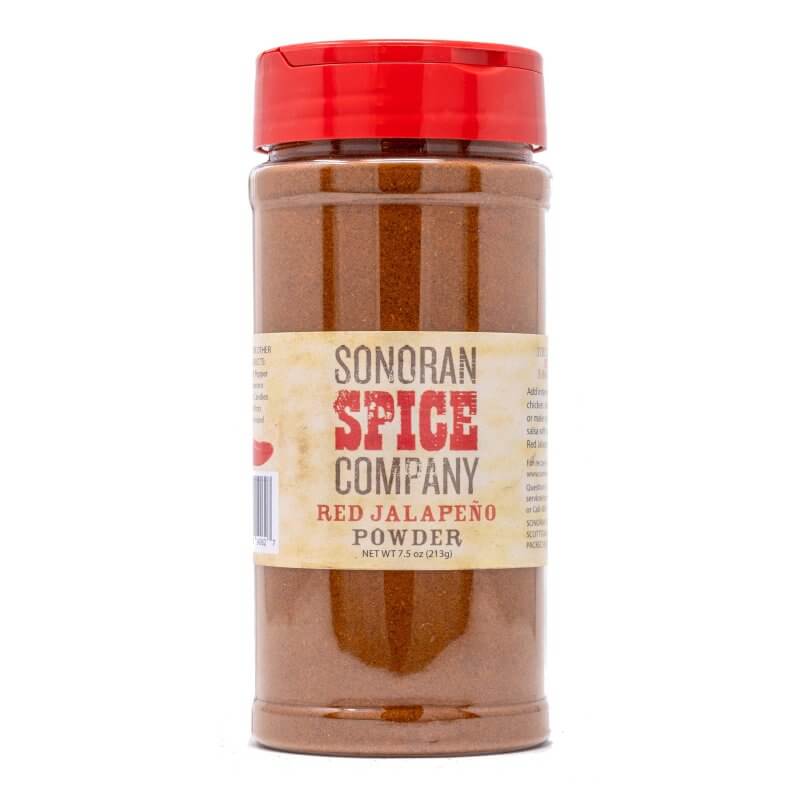Fire Roasted Red Jalapeno Pepper Powder
Fire Roasted Red Jalapeno Pepper Powder
Couldn't load pickup availability
They are not the spiciest peppers and relative to the other spices we carry they are on the very low end. Pepper spiciness or pungency is gauged on the Scoville Scale. Fire-Roasted jalapeno peppers typically have a Scoville Heat Units (SHU) rating of 2,500 to 8,500 SHU. While they are not the spiciest peppers, they make up for it with their flavor.
What do fire-roasted jalapeno peppers taste like?
Fire-roasted jalapeno peppers have a slightly smoky taste and a rich earthy flavor. Unlike our green jalapeno powder, our fire-roasted jalapeno peppers are ripened until red. They are then fire-roasted until the skins are charred. We then grind them into a fine powder that is bursting with flavor. Unlike chipotle peppers that are smoke-dried, fire-roasted jalapenos do not have an overbearing chipotle smoke flavor, it is a great alternative for anyone who likes a more mild smoky flavor.
Make a great-tasting salsa, and add a mild amount of heat to tacos, nachos, sauces, and more with our amazing ground fire-roasted jalapeno powder!
Our jalapeno powder comes to you lightning-fast in a sealed spice jar with a sifter flip top.
Shipping Configurations
1.5 oz, 3.75 oz, 8 oz, 16 oz, 1 kg - Ships in professionally sealed spice jars.
10 lbs and 44 lbs - Ships in a double-lined bag inside a box.
Looking for a larger amount?
We offer wholesale discounts on purchases over $500. You can learn about wholesale on our Wholesale Page.
Frequently Asked Questions about Jalapeño Peppers
How did jalapeño peppers get it's name?
Jalapeño peppers are named after the city of Xalapa (or Jalapa) in Mexico, where they were first cultivated. The name "jalapeño" combines "Jalapa" with the Spanish suffix "-eño," meaning "from" or "of." As these peppers spread from their native region, they carried their name with them. The term's pronunciation and spelling adapted as it entered different languages, but its origin remains a tribute to Xalapa. This is a common practice where foods are named after their place of origin.
Why is there a tilde in the name jalapeño?
The tilde in "jalapeño" is part of the letter "ñ," unique to the Spanish alphabet. It represents a palatal nasal sound not found in English, ensuring the word's correct pronunciation. Historically, "ñ" developed from "nn" to simplify writing while maintaining the sound. The tilde maintains the pepper's cultural and linguistic authenticity, linking it to its Mexican origin. Just for fun, you can type a tilde on a keyboard by holding the Alt key and typing 164 on a numeric keypad.
How hot is a jalapeño pepper?
A jalapeño pepper typically falls between 2,500 to 8,000 Scoville Heat Units (SHU), categorizing it as medium heat. This makes it hotter than bell peppers but much milder than peppers like habaneros or the world's hottest, Pepper X. The heat of jalapeños can vary, with red ones generally being hotter than green. Factors like cultivation and ripeness affect its heat level. Capsaicin, the compound responsible for the heat, is mostly found in the seeds and inner membranes.
Can dogs eat jalapeños? (Yes people ask us this!)
Dogs can eat jalapeños, but it's not recommended. The spice can cause mouth irritation, drooling, vomiting, or diarrhea. Jalapeños offer little nutritional benefit and can lead to digestive issues or pancreatitis. If given, ensure it's in tiny amounts and watch for adverse reactions. It's best to avoid feeding jalapeños to dogs unless advised by a vet.
Can kids eat jalapeños?
Kids can eat jalapeños, but their tolerance varies, so introduce them gradually. Very young children should not consume spicy foods due to the risk of irritation or choking. Always supervise kids trying jalapeños for the first time, watch for allergic reactions, and be mindful of digestive upset. Reduce heat by removing seeds and membranes, and start with small amounts. Educate children on handling spicy foods safely and respecting their spice tolerance.
Are jalapeños good for you?
Jalapeños are beneficial due to their low calorie, high nutrient content, including vitamins C, A, B6, and K. They contain capsaicin, which has antioxidant, metabolism-boosting, and pain-relieving properties. Jalapeños offer fiber for digestive health and can support heart health with potassium.
What recipes are jalapeño peppers commonly used in?
Jalapeño peppers are frequently used in a variety of dishes for their spicy flavor. They are key in making jalapeño poppers, stuffed with cheese and fried or baked. Jalapeños are common in salsas, guacamole, and as a topping for nachos, tacos, and burritos. They're also pickled, used in chili con carne, or incorporated into cornbread and bread recipes. Additionally, jalapeños feature in spicy dips like jalapeño popper dip, in soups, and even in sweet applications like jalapeño jelly.
Is jalapeño a fruit?
Yes, jalapeño is indeed a fruit. Botanically speaking, any part of a plant that develops from a flower and contains seeds is classified as a fruit. Jalapeño peppers are the fruit of the plant Capsicum annuum, just as tomatoes, cucumbers, and avocados are fruits, despite being commonly considered vegetables in culinary contexts.
How to get jalapeno off hands?
To remove jalapeño heat from hands, wash with dish soap to dissolve the capsaicin oil. Rubbing hands with oil before washing can also help lift the capsaicin. Use baking soda paste, alcohol, or milk to neutralize or dissolve the capsaicin. Avoid touching sensitive areas and use lukewarm or cool water. If discomfort persists, consider using capsaicin-counteracting creams.
What is the most interesting thing about jalapeno peppers?
Jalapeños are fascinating for their ability to change color and heat as they ripen, starting green and turning red, with red ones often being hotter. They exhibit "corking," white lines that indicate faster ripening, potentially adding flavor or sweetness, though not always more heat. Capsaicin from jalapeños is used medicinally for pain relief, highlighting their health benefits. They hold a significant place in Mexican and Southwestern U.S. cuisine, symbolizing cultural identity. Additionally, jalapeños are prolific producers and have been crossbred to create varieties with less heat, expanding their culinary use.
Why do jalapenos put on a sweater?
Because they are a little chili :)
Additional Info
Want to learn more about Jalapeno Peppers? Be sure to check out
The Ultimate Guide to Jalapeño Peppers on our blog.
Share











